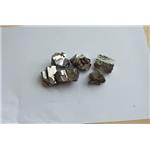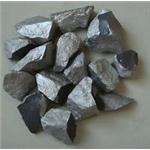Description
Ferrovanadium, a noncombustible solid; thedust may be an explosion hazard. It consists of dark, odorless solid particles (particulate): dispersed in air. An alloyhaving the composition of 50-80% vanadium with iron,carbon, trace silicon, manganese, chromium, nickel, etc.Molecular weight=106.8; Freezing/Meltingpoint=1482-1521 C; Minimum explosive concentration(MEC)=1.3 g/m3.[NIOSH] Insoluble in water.
Chemical Properties
Ferrovanadium, a noncombustible solid; the
dust may be an explosion hazard. It consists of dark,
odorless solid particles (particulate): dispersed in air. An
alloy having the composition of 50% 80% vanadium
with iron, carbon, and trace silicon, manganese, chro mium, nickel, etc.
Uses
Added to steel to produce fineness of
grain, toughness, and resistance to high temperature
and torsion
Definition
An iron–vanadium alloy used to add vanadium to
steel. Vanadium is used in engineering steels to the
extent of 0.1–0.25% and in high-speed steels to the
extent of 1–2.5% or higher. Melting range 1482–
1521C. Furnished in a variety of lump, crushed,
and gro
Hazard
Moderate fire risk.
Health Hazard
Ferrovanadium dust is a mild
irritant of the eyes and respiratory tract.
Safety Profile
Can cause pulmonary
damage. Combustible when exposed to heat
or flame. See also VANADIUM and IRON.
Potential Exposure
Ferrovanadium is added to steel to
produce fineness of grain, toughness, torsion properties;
and resistance to high temperatures.
First aid
If this chemical gets into the eyes, remove any contact lenses at once and irrigate immediately for at least15 min, occasionally lifting upper and lower lids. Seek medical attention immediately. If this chemical contacts the skin,remove contaminated clothing and wash immediately withsoap and water. Seek medical attention immediately. If thischemical has been inhaled, remove from exposure, begin rescue breathing (using universal precautions, including resuscitation mask) if breathing has stopped and CPR if heart actionhas stopped. Transfer promptly to a medical facility. Whenthis chemical has been swallowed, get medical attention.Give large quantities of water and induce vomiting. Do notmake an unconscious person vomit.Note to physician: For severe poisoning do not use BAL[British Anti-Lewisite, dimercaprol, dithiopropanol(C3H8OS2)] as it is contraindicated or ineffective in poisoning from iron.
storage
Dust is an explosion hazard. Prior to working withthis material, you should be trained on its proper handlingand storage. Store in tightly closed containers in a cool,well-ventilated area away from oxidizers.
Incompatibilities
Incompatible with oxidizers (chlorates,
nitrates, peroxides, permanganates, perchlorates, chlorine,
bromine, fluorine, etc.); contact may cause fires or explo sions. Keep away from alkaline materials, strong bases,
strong acids, oxoacids, epoxides.
Waste Disposal
Disposal in a sanitary landfill.



